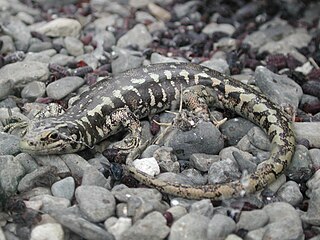
Oligosoma is a genus of small to medium-sized skinks found only in New Zealand, Norfolk Island and Lord Howe Island. Oligosoma had previously been found to belong to the Eugongylus group of genera in the subfamily Lygosominae; the Australian genus Bassiana appears to be fairly closely related.

The long-toed skink is a species of skink of the family Scincidae, endemic to New Zealand. It was first described by Geoff Patterson in 1997. It is only known from a few sites in the South Island of New Zealand and little is known of its habits. It seems to prefer dry, rocky habitats, usually eroding stream terraces or scree slopes. It is diurnal and heliothermic. Maximum snout-vent length is about 70 mm.

The Otago skink is a rare, endangered species of large skink in the family Scincidae, found in the rocky canyons and grassy patches of Central Otago, New Zealand.

The grand skink is an endangered species of large skink endemic to the central Otago region of New Zealand.

The copper skink is a skink of the family Scincidae that is endemic to the North Island of New Zealand.

The New Zealand striped skink is a rare species of medium-sized skink endemic to New Zealand. Found in the North Island, Great Barrier Island and Little Barrier Island, the species is primarily arboreal, living in dense native tree canopies.

Oligosoma alani,, also known as the robust skink is the largest endemic skink to New Zealand. The robust skink is in the family Scincidae and found in the protected nature reserves of the Mercury Islands in the North Island of New Zealand. The robust skink has an at risk - recovering conservation status.

Whitaker's skink, also known commonly as Whitaker's New Zealand skink, is an endangered species of skink, a lizard in the family Scincidae. The species is found only in New Zealand.
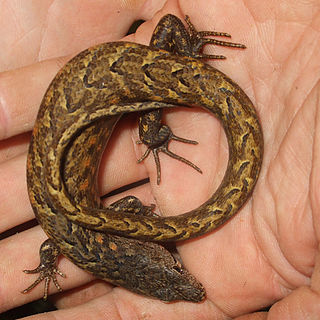
The chevron skink is a large species of skink that is endemic to New Zealand. Previously found across Northland and the northern Auckland Region, it is now found only on the Great Barrier and Little Barrier islands in the Hauraki Gulf. A cryptic forest dweller, it can hide underwater. The chevron skink is the longest species of skink in New Zealand, reaching lengths of up to 340 mm (13 in). It is under threat from introduced rats.
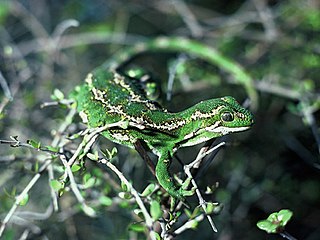
The jewelled gecko is a threatened species of lizard in the family Diplodactylidae. The species is endemic to the South Island of New Zealand.

Woodworthia maculata, also known as the New Zealand common gecko or Raukawa gecko, is a species in the family Diplodactylidae. The species is endemic to New Zealand.

Oligosoma nigriplantare, the Chatham Islands skink, is a species of skink in the family Scincidae.

Oligosoma suteri, known commonly as Suter's skink, the black shore skink, the egg-laying skink, and Suter's ground skink, is a species of lizard in the family Scincidae. The species is endemic to New Zealand, found in fragmented populations on the mainland of the Coromandel Peninsula as far south as the Coromandel Peninsula, and on offshore northern islands of New Zealand.

Oligosoma taumakae, the Open Bay Island(s) skink, or Taumaka skink, is a species of skink. It was described from the Open Bay Islands, off the west coast of the South Island of New Zealand.
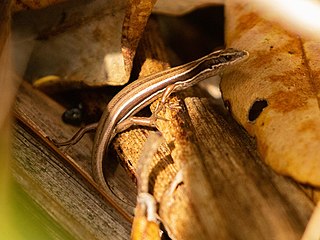
The moko skink is a species of lizard in the family Scincidae (skinks) that is endemic to New Zealand.

The Aorangi skink is a species of lizards in the skink family. The species is native to New Zealand.

The Te Kakahu skink is a critically endangered species of skink native to New Zealand. When discovered, the entire species was inhabiting a single patch of clifftop vegetation on Chalky Island in Fiordland National Park.

The Burgan skink is a nationally endangered species of skink native to New Zealand. It was described from a specimen found near the Burgan Stream, in the Rock and Pillar Range, Central Otago.
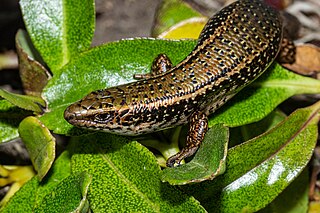
Oligosoma lineoocellatum, commonly known as the Canterbury spotted skink, is one of a species complex of several related spotted skink species from New Zealand.

The Canterbury gecko is a gecko found in the South Island of New Zealand. It is also known by the Māori names Waitaha gecko and Moko-pāpā, and as the brown gecko. It had previously been placed in a different genus and called Hoplodactylus brunneus, but further study split the genus Hoplodactylus into six genera, with some groups close to the former Hoplodactylus maculatus "Canterbury" being assigned to the new genus Woodworthia.





















